One of the most heavily-used parts of Triple Cities Makerspace is the Metal Shop, where members can frequently be found using its equipment to cut, mill, and weld to their hearts’ content. The person in charge of this area of the Makerspace is Cliff Burger, a mechanical engineer by trade and an enthusiastic machinist and metal-worker in his spare time! Cliff has worked on many group and personal projects in the Metal Shop for practical purposes, but recently he’s also finished a personal project for fun there – knife-making! He was inspired to do this after seeing some knife-making projects discussed in various online machinist forums, and decided that he wanted to put his personal touch on the general idea.
Cliff has produced two different kinds of knives so far. The simplest kind is one he made from a repurposed coarse wood file, chosen for its appropriate size as a piece of raw material as well as the high quality of its steel. A good knife blade will have a high carbon content, which allows the blade to have a sharper and more durable edge; and good files like the one he used are usually made with a high carbon variety of steel. The second knife was made from a stock piece of steel with a mixture of high-carbon and nickel-based stainless steel components for aesthetic purposes.
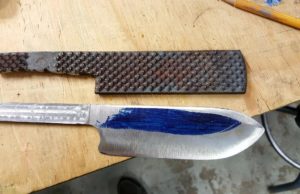
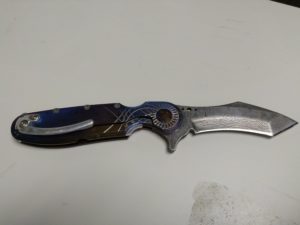
The process of making the blades for both knives is largely the same. The first step in the process is called annealing, where the raw material for the blade is heated to 800-1000 ℉ in a miniature kiln or specialty oven. This softens the material enough so that it can be reshaped into the form of a blade. A mill is used to do the three-dimensional reshaping, by trimming away any excess metal from the raw material until what is left is the desired size and shape; Cliff used a special carbide bit in the mill which could easily cut through the still relatively tough steel. The new blade is then given a beveled edge on its appropriate side using a belt sander.
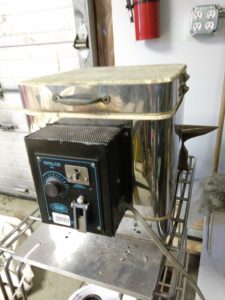
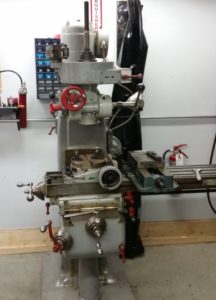
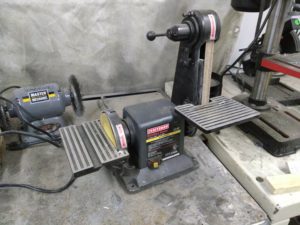
Once the blade has been created, it must be treated to regain its toughness, where toughness is defined as strength of material, vs. hardness as the ability to resist deformation – the former quality is desired for a knife blade, for the sake of having it not break if too much force is applied. Cliff reheated the blade to 1000-1200 ℉, then immediately quenched it in a bucket of salt water (brine). Finally, he placed the blade in a 400℉ oven for an hour, let it cool to room temperature, then ran it through the oven at 400℉ for another hour before letting it cool again. This process is called tempering, which leaves the carbon inside the blade at a high-energy (and very tough) state, even when the blade has cooled to room temperature.
The blade is given a final finish using sandpaper of various grits – starting at 300, and working up to 1000 or 2000 – and a thorough application of polishing compound, so that it looks as awesome as it is tough! The second knife Cliff created especially benefited from the finishing process, as the pattern exposed with the sanding and polishing is gorgeous. Cliff used diamond honing stones to put a fine edge on both knife blades, which should last for a long time even with regular use because of the high strength of the materials. The first knife is currently having a wooden handle created for it out of two separate pieces of wood, called scales, which will be screwed to the butt end of the blade. The second knife has a much finer set of scales made of grade 2 anodised titanium, which Cliff enhanced by milling an artistic pattern into both scales, and by adding a frame lock and hinge to keep the blade extended once opened.
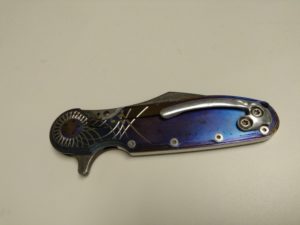
The second knife has been used regularly for every day handyman purposes since Cliff finished making it, and the first will see regular use as a kitchen knife once its scales are finished and installed! Two other members of the Makerspace have shown interest in making their own knives after seeing the ones Cliff made, and he is currently walking them through the process of making kitchen knives from files as he did. Hopefully more people will be inspired by his example to make their own practical and useful tools!
Picture References:
All pictures provided and owned by Cliff Burger and Stephen Welte
